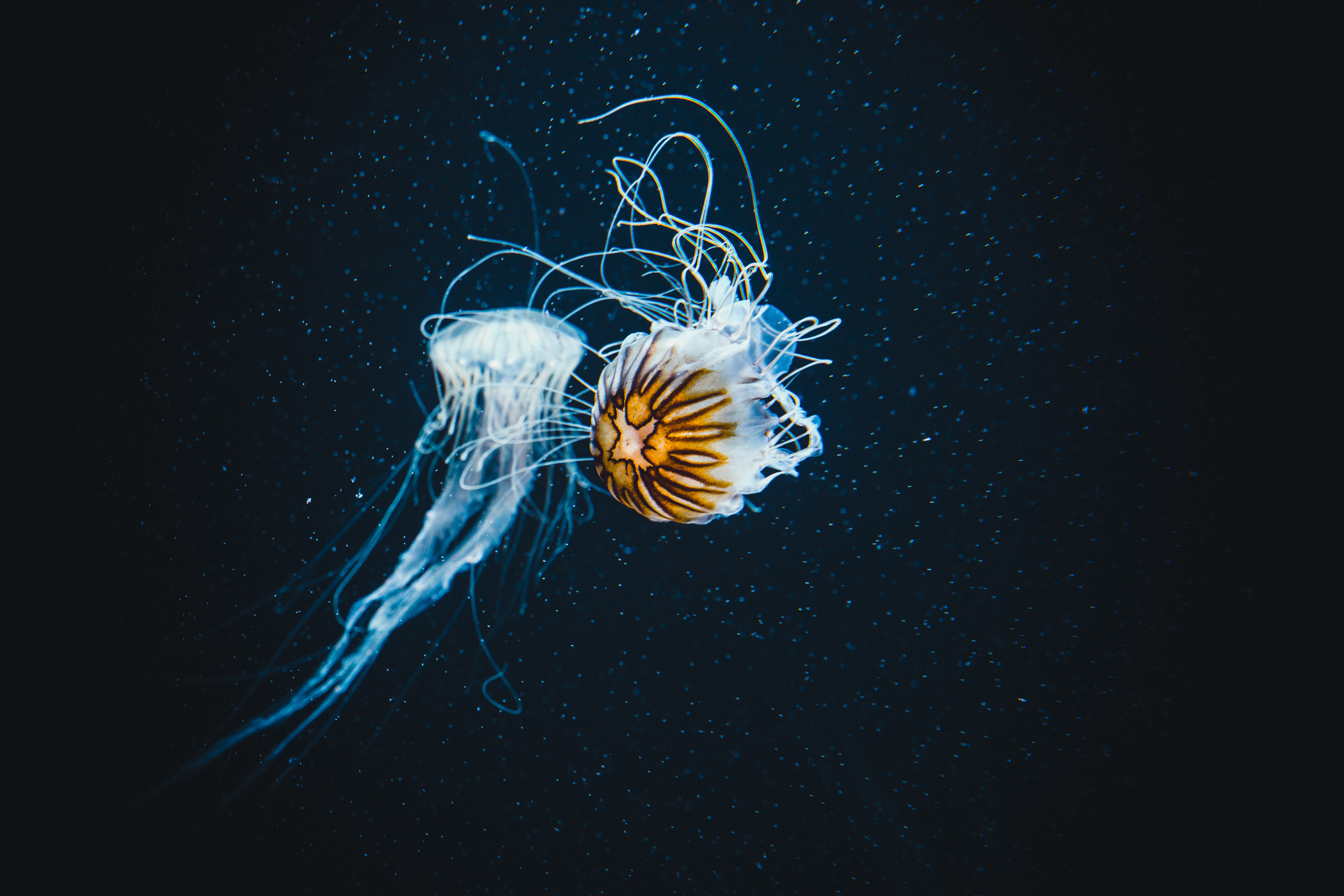|
Chrysaora Pacifica
''Chrysaora pacifica'', commonly named the Japanese sea nettle, is a jellyfish in the family Pelagiidae. This common species is native to the northwest Pacific Ocean, including Japan and Korea, but it was formerly confused with the larger and more northerly distributed '' C. melanaster''. As a consequence, individuals kept in public aquariums have often been mislabelled as ''C. melanaster''. The medusae Jellyfish and sea jellies are the informal common names given to the medusa-phase of certain gelatinous members of the subphylum Medusozoa, a major part of the phylum Cnidaria. Jellyfish are mainly free-swimming marine animals with umbrella- ... of ''C. pacifica'' typically has a bell with a diameter of . Its sting is strong and can be dangerous to humans. References Chrysaora Animals described in 1886 {{scyphozoa-stub ... [...More Info...] [...Related Items...] OR: [Wikipedia] [Google] [Baidu] |
Jellyfish
Jellyfish and sea jellies are the informal common names given to the medusa-phase of certain gelatinous members of the subphylum Medusozoa, a major part of the phylum Cnidaria. Jellyfish are mainly free-swimming marine animals with umbrella-shaped bells and trailing tentacles, although a few are anchored to the seabed by stalks rather than being mobile. The bell can pulsate to provide propulsion for highly efficient animal locomotion, locomotion. The tentacles are armed with Cnidocyte, stinging cells and may be used to capture prey and defend against predators. Jellyfish have a complex Biological life cycle, life cycle; the medusa is normally the sexual phase, which produces planula larvae that disperse widely and enter a sedentary polyp (zoology), polyp phase before reaching sexual maturity. Jellyfish are found all over the world, from surface waters to the deep sea. Scyphozoans (the "true jellyfish") are exclusively marine habitats, marine, but some hydrozoans with a simila ... [...More Info...] [...Related Items...] OR: [Wikipedia] [Google] [Baidu] |
Pelagiidae
The Pelagiidae are a family of jellyfish. Members of the family ''Pelagiidae'' have no ring canal, and the marginal tentacles arise from umbrella margin. Genera There are four genera currently recognized: *Genus ''Chrysaora'' – (14 species) *Genus ''Mawia'' – ''Mawia benovici'' *Genus ''Pelagia'' – ''Pelagia noctiluca'' *Genus ''Sanderia ''Sanderia'' is a genus of jellyfish in the family Pelagiidae The Pelagiidae are a family of jellyfish. Members of the family ''Pelagiidae'' have no ring canal, and the marginal tentacles arise from umbrella margin. Genera There are four gener ...'' – (2 species) References Cnidarian families Semaeostomeae {{Scyphozoa-stub ... [...More Info...] [...Related Items...] OR: [Wikipedia] [Google] [Baidu] |
Chrysaora Melanaster
''Chrysaora melanaster'', commonly known as the northern sea nettle or brown jellyfish, is a species of jellyfish native to the northern Pacific Ocean and adjacent parts of the Arctic Ocean. It is sometimes referred to as a Pacific sea nettle, but this name is also used for '' C. fuscescens''; the name Japanese sea nettle was also used for this species, but that name now exclusively refers to '' C. pacifica''. Although jellyfish kept in public aquariums sometimes are referred to as ''C. melanaster'', this is the result of the historical naming confusion and these actually are ''C. pacifica''. Description The medusa of the northern sea nettle can reach in diameter with tentacles growing up to .CNET newsChrysaora melanaster from "Census of Marine Life reveals hidden life in oceans" article (October 5, 2010). The number of tentacles is up to 24 (three per octant). It dwells at depths of up to 100 meters, where it feeds on copepods, larvaceans, small fish, large zooplankton, and ... [...More Info...] [...Related Items...] OR: [Wikipedia] [Google] [Baidu] |
Public Aquarium
A public aquarium (plural: ''public aquaria'' or ''public Water Zoo'') is the aquatic counterpart of a zoo, which houses living aquatic animal and plant specimens for public viewing. Most public aquariums feature tanks larger than those kept by home aquarists, as well as smaller tanks. Since the first public aquariums were built in the mid-19th century, they have become popular and their numbers have increased. Most modern accredited aquariums stress conservation issues and educating the public.Visitor Impact accessed 3 February 2007. History [...More Info...] [...Related Items...] OR: [Wikipedia] [Google] [Baidu] |
Medusae
Jellyfish and sea jellies are the informal common names given to the medusa-phase of certain gelatinous members of the subphylum Medusozoa, a major part of the phylum Cnidaria. Jellyfish are mainly free-swimming marine animals with umbrella-shaped bells and trailing tentacles, although a few are anchored to the seabed by stalks rather than being mobile. The bell can pulsate to provide propulsion for highly efficient locomotion. The tentacles are armed with stinging cells and may be used to capture prey and defend against predators. Jellyfish have a complex life cycle; the medusa is normally the sexual phase, which produces planula larvae that disperse widely and enter a sedentary polyp phase before reaching sexual maturity. Jellyfish are found all over the world, from surface waters to the deep sea. Scyphozoans (the "true jellyfish") are exclusively marine, but some hydrozoans with a similar appearance live in freshwater. Large, often colorful, jellyfish are common in coa ... [...More Info...] [...Related Items...] OR: [Wikipedia] [Google] [Baidu] |
Chrysaora
''Chrysaora'' () is a genus of jellyfish, commonly called the sea nettles, in the family Pelagiidae. The origin of the genus name ''Chrysaora'' lies in Greek mythology with Chrysaor, brother of Pegasus and son of Poseidon and Medusa. Translated, ''Chrysaor'' means "he who has a golden armament." Species There are 16 recognized species in the genus ''Chrysaora'': * '' Chrysaora achlyos'' – black sea nettle * '' Chrysaora africana'' * ''Chrysaora agulhensis'' * ''Chrysaora chesapeakei'' - Atlantic bay nettle * '' Chrysaora chinensis'' * ''Chrysaora colorata'' – purple-striped jelly * ''Chrysaora fulgida'' * ''Chrysaora fuscescens'' – Pacific sea nettle * ''Chrysaora helvola'' * ''Chrysaora hysoscella'' – compass jellyfish * ''Chrysaora lactea'' * ''Chrysaora melanaster'' – northern sea nettle * ''Chrysaora pacifica'' – Japanese sea nettle * ''Chrysaora pentastoma'' * ''Chrysaora plocamia'' – South American sea nettle * ''Chrysaora quinquecirrha T ... [...More Info...] [...Related Items...] OR: [Wikipedia] [Google] [Baidu] |



